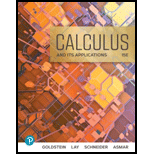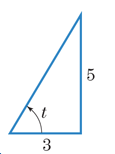
Pearson eText for Calculus & Its Applications -- Instant Access (Pearson+)
15th Edition
ISBN: 9780137590728
Author: Larry Goldstein, David Lay
Publisher: PEARSON+
expand_more
expand_more
format_list_bulleted
Question
Chapter 8.2, Problem 6E
To determine
The value of

Expert Solution & Answer
Want to see the full answer?
Check out a sample textbook solution
Students have asked these similar questions
Find the indefinite integral.
Check
Answer:
7x
4 + 1x
dx
show sketch
Find the indefinite integral.
Check
Answer:
7x
4 + 1x
dx
Chapter 8 Solutions
Pearson eText for Calculus & Its Applications -- Instant Access (Pearson+)
Ch. 8.1 - A right triangle has one angle of /3 radians. What...Ch. 8.1 - Prob. 2CYUCh. 8.1 - Prob. 1ECh. 8.1 - Prob. 2ECh. 8.1 - Prob. 3ECh. 8.1 - Prob. 4ECh. 8.1 - Give the radian measure of each angle described.Ch. 8.1 - Prob. 6ECh. 8.1 - Prob. 7ECh. 8.1 - Prob. 8E
Ch. 8.1 - Prob. 9ECh. 8.1 - Prob. 10ECh. 8.1 - Prob. 11ECh. 8.1 - Prob. 12ECh. 8.1 - Prob. 13ECh. 8.1 - Prob. 14ECh. 8.1 - Prob. 15ECh. 8.1 - Prob. 16ECh. 8.1 - Prob. 17ECh. 8.1 - Prob. 18ECh. 8.2 - Find cost, where t is the radian measure of the...Ch. 8.2 - Prob. 2CYUCh. 8.2 - Prob. 1ECh. 8.2 - Prob. 2ECh. 8.2 - Prob. 3ECh. 8.2 - Prob. 4ECh. 8.2 - In Exercises 112, give the values of sint and...Ch. 8.2 - Prob. 6ECh. 8.2 - Prob. 7ECh. 8.2 - Prob. 8ECh. 8.2 - Prob. 9ECh. 8.2 - Prob. 10ECh. 8.2 - Prob. 11ECh. 8.2 - Prob. 12ECh. 8.2 - Prob. 13ECh. 8.2 - Prob. 14ECh. 8.2 - Prob. 15ECh. 8.2 - Prob. 16ECh. 8.2 - Prob. 17ECh. 8.2 - Prob. 18ECh. 8.2 - Prob. 19ECh. 8.2 - Prob. 20ECh. 8.2 - Prob. 21ECh. 8.2 - Prob. 22ECh. 8.2 - Prob. 23ECh. 8.2 - Prob. 24ECh. 8.2 - Prob. 25ECh. 8.2 - Prob. 26ECh. 8.2 - Prob. 27ECh. 8.2 - Prob. 28ECh. 8.2 - Prob. 29ECh. 8.2 - Prob. 30ECh. 8.2 - Prob. 31ECh. 8.2 - Prob. 32ECh. 8.2 - Prob. 33ECh. 8.2 - Prob. 34ECh. 8.2 - Prob. 35ECh. 8.2 - Prob. 36ECh. 8.2 - Prob. 37ECh. 8.2 - Prob. 38ECh. 8.2 - Prob. 39ECh. 8.2 - Prob. 40ECh. 8.2 - Prob. 41ECh. 8.2 - In any given locality, the length of daylight...Ch. 8.3 - Differentiate y=2sin[t2+(/6)].Ch. 8.3 - Prob. 2CYUCh. 8.3 - Prob. 1ECh. 8.3 - Prob. 2ECh. 8.3 - Prob. 3ECh. 8.3 - Prob. 4ECh. 8.3 - Differentiate (with respect to t or x): y=2cos3tCh. 8.3 - Differentiate (with respect to t or x): y=sin3t3Ch. 8.3 - Prob. 7ECh. 8.3 - Differentiate (with respect to t or x): y=tcostCh. 8.3 - Prob. 9ECh. 8.3 - Prob. 10ECh. 8.3 - Differentiate (with respect to t or x): y=cos3tCh. 8.3 - Prob. 12ECh. 8.3 - Prob. 13ECh. 8.3 - Prob. 14ECh. 8.3 - Prob. 15ECh. 8.3 - Prob. 16ECh. 8.3 - Prob. 17ECh. 8.3 - Prob. 18ECh. 8.3 - Prob. 19ECh. 8.3 - Prob. 20ECh. 8.3 - Prob. 21ECh. 8.3 - Prob. 22ECh. 8.3 - Prob. 23ECh. 8.3 - Prob. 24ECh. 8.3 - Prob. 25ECh. 8.3 - Prob. 26ECh. 8.3 - Prob. 27ECh. 8.3 - Prob. 28ECh. 8.3 - Prob. 29ECh. 8.3 - Prob. 30ECh. 8.3 - Prob. 31ECh. 8.3 - Prob. 32ECh. 8.3 - Prob. 33ECh. 8.3 - Prob. 34ECh. 8.3 - Prob. 35ECh. 8.3 - Prob. 36ECh. 8.3 - Prob. 37ECh. 8.3 - Prob. 38ECh. 8.3 - Prob. 39ECh. 8.3 - Prob. 40ECh. 8.3 - Prob. 41ECh. 8.3 - Prob. 42ECh. 8.3 - Prob. 43ECh. 8.3 - Prob. 44ECh. 8.3 - Prob. 45ECh. 8.3 - Prob. 46ECh. 8.3 - Prob. 47ECh. 8.3 - Prob. 48ECh. 8.3 - Prob. 49ECh. 8.3 - Prob. 50ECh. 8.3 - Prob. 51ECh. 8.3 - Average Daylight Hours The number of hours of...Ch. 8.4 - Prob. 1CYUCh. 8.4 - Prob. 2CYUCh. 8.4 - Prob. 1ECh. 8.4 - Prob. 2ECh. 8.4 - Prob. 3ECh. 8.4 - Prob. 4ECh. 8.4 - Prob. 5ECh. 8.4 - Prob. 6ECh. 8.4 - Prob. 7ECh. 8.4 - In Exercises 310, give the values of tant and...Ch. 8.4 - Prob. 9ECh. 8.4 - Prob. 10ECh. 8.4 - Prob. 11ECh. 8.4 - The angle of elevation from an observer to the top...Ch. 8.4 - Prob. 13ECh. 8.4 - Prob. 14ECh. 8.4 - Prob. 15ECh. 8.4 - Prob. 16ECh. 8.4 - Prob. 17ECh. 8.4 - Prob. 18ECh. 8.4 - Prob. 19ECh. 8.4 - Prob. 20ECh. 8.4 - Prob. 21ECh. 8.4 - Prob. 22ECh. 8.4 - Prob. 23ECh. 8.4 - Prob. 24ECh. 8.4 - Prob. 25ECh. 8.4 - Prob. 26ECh. 8.4 - Prob. 27ECh. 8.4 - Prob. 28ECh. 8.4 - Prob. 29ECh. 8.4 - Prob. 30ECh. 8.4 - Prob. 31ECh. 8.4 - Prob. 32ECh. 8.4 - Prob. 33ECh. 8.4 - Prob. 34ECh. 8.4 - Prob. 35ECh. 8.4 - Prob. 36ECh. 8.4 - Prob. 37ECh. 8.4 - Prob. 38ECh. 8.4 - Prob. 39ECh. 8.4 - Prob. 40ECh. 8 - Explain the radian measure of an angle.Ch. 8 - Prob. 2FCCECh. 8 - Prob. 3FCCECh. 8 - Prob. 4FCCECh. 8 - Prob. 5FCCECh. 8 - Prob. 6FCCECh. 8 - Prob. 7FCCECh. 8 - Prob. 8FCCECh. 8 - Prob. 9FCCECh. 8 - Prob. 10FCCECh. 8 - Prob. 1RECh. 8 - Prob. 2RECh. 8 - Prob. 3RECh. 8 - Prob. 4RECh. 8 - Prob. 5RECh. 8 - Prob. 6RECh. 8 - Prob. 7RECh. 8 - Prob. 8RECh. 8 - Prob. 9RECh. 8 - Prob. 10RECh. 8 - Prob. 11RECh. 8 - Prob. 12RECh. 8 - Prob. 13RECh. 8 - Prob. 14RECh. 8 - Prob. 15RECh. 8 - Prob. 16RECh. 8 - Prob. 17RECh. 8 - Prob. 18RECh. 8 - Prob. 19RECh. 8 - Prob. 20RECh. 8 - Prob. 21RECh. 8 - Prob. 22RECh. 8 - Prob. 23RECh. 8 - Prob. 24RECh. 8 - Prob. 25RECh. 8 - Prob. 26RECh. 8 - Prob. 27RECh. 8 - Prob. 28RECh. 8 - Prob. 29RECh. 8 - Prob. 30RECh. 8 - Prob. 31RECh. 8 - Prob. 32RECh. 8 - Prob. 33RECh. 8 - Prob. 34RECh. 8 - Prob. 35RECh. 8 - Differentiate (with respect to t or x): y=ln(cosx)Ch. 8 - Prob. 37RECh. 8 - Prob. 38RECh. 8 - Prob. 39RECh. 8 - Prob. 40RECh. 8 - Prob. 41RECh. 8 - Prob. 42RECh. 8 - Prob. 43RECh. 8 - Prob. 44RECh. 8 - Prob. 45RECh. 8 - Prob. 46RECh. 8 - Prob. 47RECh. 8 - Prob. 48RECh. 8 - Prob. 49RECh. 8 - Prob. 50RECh. 8 - Prob. 51RECh. 8 - Prob. 52RECh. 8 - Prob. 53RECh. 8 - Prob. 54RECh. 8 - Prob. 55RECh. 8 - Prob. 56RECh. 8 - Prob. 57RECh. 8 - Prob. 58RECh. 8 - Prob. 59RECh. 8 - Prob. 60RECh. 8 - Prob. 61RECh. 8 - Prob. 62RECh. 8 - Prob. 63RECh. 8 - Prob. 64RECh. 8 - Prob. 65RECh. 8 - Prob. 66RECh. 8 - Prob. 67RECh. 8 - In Fig. 2: Find the Shaded area A2.Ch. 8 - Prob. 69RECh. 8 - Prob. 70RECh. 8 - Prob. 71RECh. 8 - Prob. 72RECh. 8 - Prob. 73RECh. 8 - Prob. 74RECh. 8 - Prob. 75RECh. 8 - Prob. 76RECh. 8 - Evaluate the given integral. [ Hint: Use identity...Ch. 8 - Prob. 78RECh. 8 - Prob. 79RECh. 8 - Prob. 80RE
Knowledge Booster
Learn more about
Need a deep-dive on the concept behind this application? Look no further. Learn more about this topic, calculus and related others by exploring similar questions and additional content below.Similar questions
- Here is a region R in Quadrant I. y 2.0 T 1.5 1.0 0.5 0.0 + 55 0.0 0.5 1.0 1.5 2.0 X It is bounded by y = x¹/3, y = 1, and x = 0. We want to evaluate this double integral. ONLY ONE order of integration will work. Good luck! The dA =???arrow_forward43–46. Directions of change Consider the following functions f and points P. Sketch the xy-plane showing P and the level curve through P. Indicate (as in Figure 15.52) the directions of maximum increase, maximum decrease, and no change for f. ■ 45. f(x, y) = x² + xy + y² + 7; P(−3, 3)arrow_forwardEX-let d'be ametric on a vector space X induced from a norm hx and d defind by a Slab)= {od (a, if a = b (a,b)+is ab Show that cannot be induced froman norm on X. 2) let à be trivel metric show that I cannot be induced from an norm on X- 3) let M be closed subspace of anormed spacex Construct the space X/Mas a normed space. 4) let Mix be vector space of 2x3 matrices on R write with Prove convex set and hyper Plane of M 5) show that every a finite dimension subspace of anormed space is closed.arrow_forward
- please do #48arrow_forward43–46. Directions of change Consider the following functions f and points P. Sketch the xy-plane showing P and the level curve through P. Indicate (as in Figure 15.52) the directions of maximum increase, maximum decrease, and no change for f. ■ 45. f(x, y) = x² + xy + y² + 7; P(−3, 3)arrow_forwardplese do #48arrow_forward
arrow_back_ios
SEE MORE QUESTIONS
arrow_forward_ios
Recommended textbooks for you
 Trigonometry (MindTap Course List)TrigonometryISBN:9781337278461Author:Ron LarsonPublisher:Cengage Learning
Trigonometry (MindTap Course List)TrigonometryISBN:9781337278461Author:Ron LarsonPublisher:Cengage Learning Trigonometry (MindTap Course List)TrigonometryISBN:9781305652224Author:Charles P. McKeague, Mark D. TurnerPublisher:Cengage LearningAlgebra & Trigonometry with Analytic GeometryAlgebraISBN:9781133382119Author:SwokowskiPublisher:Cengage
Trigonometry (MindTap Course List)TrigonometryISBN:9781305652224Author:Charles P. McKeague, Mark D. TurnerPublisher:Cengage LearningAlgebra & Trigonometry with Analytic GeometryAlgebraISBN:9781133382119Author:SwokowskiPublisher:Cengage Mathematics For Machine TechnologyAdvanced MathISBN:9781337798310Author:Peterson, John.Publisher:Cengage Learning,
Mathematics For Machine TechnologyAdvanced MathISBN:9781337798310Author:Peterson, John.Publisher:Cengage Learning, Elementary Geometry For College Students, 7eGeometryISBN:9781337614085Author:Alexander, Daniel C.; Koeberlein, Geralyn M.Publisher:Cengage,
Elementary Geometry For College Students, 7eGeometryISBN:9781337614085Author:Alexander, Daniel C.; Koeberlein, Geralyn M.Publisher:Cengage, Elementary Geometry for College StudentsGeometryISBN:9781285195698Author:Daniel C. Alexander, Geralyn M. KoeberleinPublisher:Cengage Learning
Elementary Geometry for College StudentsGeometryISBN:9781285195698Author:Daniel C. Alexander, Geralyn M. KoeberleinPublisher:Cengage Learning

Trigonometry (MindTap Course List)
Trigonometry
ISBN:9781337278461
Author:Ron Larson
Publisher:Cengage Learning

Trigonometry (MindTap Course List)
Trigonometry
ISBN:9781305652224
Author:Charles P. McKeague, Mark D. Turner
Publisher:Cengage Learning

Algebra & Trigonometry with Analytic Geometry
Algebra
ISBN:9781133382119
Author:Swokowski
Publisher:Cengage

Mathematics For Machine Technology
Advanced Math
ISBN:9781337798310
Author:Peterson, John.
Publisher:Cengage Learning,

Elementary Geometry For College Students, 7e
Geometry
ISBN:9781337614085
Author:Alexander, Daniel C.; Koeberlein, Geralyn M.
Publisher:Cengage,

Elementary Geometry for College Students
Geometry
ISBN:9781285195698
Author:Daniel C. Alexander, Geralyn M. Koeberlein
Publisher:Cengage Learning
Chain Rule dy:dx = dy:du*du:dx; Author: Robert Cappetta;https://www.youtube.com/watch?v=IUYniALwbHs;License: Standard YouTube License, CC-BY
CHAIN RULE Part 1; Author: Btech Maths Hub;https://www.youtube.com/watch?v=TIAw6AJ_5Po;License: Standard YouTube License, CC-BY